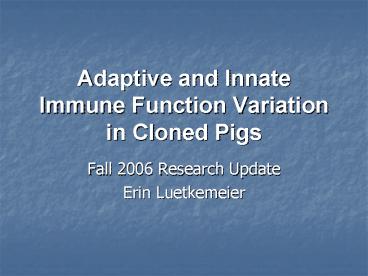Adaptive and Innate Immune Function Variation in Cloned Pigs - PowerPoint PPT Presentation
1 / 18
Title:
Adaptive and Innate Immune Function Variation in Cloned Pigs
Description:
Adaptive and Innate Immune Function Variation in Cloned Pigs. Fall 2006 Research Update ... significantly less immune variation observed in the indoor reared clones as ... – PowerPoint PPT presentation
Number of Views:31
Avg rating:3.0/5.0
Title: Adaptive and Innate Immune Function Variation in Cloned Pigs
1
Adaptive and Innate Immune Function Variation in
Cloned Pigs
- Fall 2006 Research Update
- Erin Luetkemeier
2
- The objective of this study is to determine the
relative influence of genetic makeup and the
environment on the variation of porcine adaptive
and innate immune responses. - Lymphocyte function
- Innate immune function
- Adaptive immunity
3
Identical PBMC Response to polyclonal T cell
activators
4
Environmental Impact on IFN-a production
5
Environmental Impact on IFN-a production
6
IFN-a Conclusions
- Both sets of clones and the controls
- demonstrated significant differences when
comparing their responses to CpG - Outdoor clones versus indoor clones
- When comparing their coefficient of variations,
it was observed that the indoor clones
demonstrated less immune variation than the
outdoor clones. - Through F-test evaluation (F-critical 0.05, 3,3
of 19.16) there were no significant values
7
Phenotypic Analysis of PBMC
- CD4CD8-, CD4-CD8, and CD4CD8
- Identify the presence of T and B cells
- CD 29 high and low
- Identify the presence of activated T or memory T
cells
8
PBMC Phenotypes
Dead
Live
9
PBMC Phenotypes
10
PBMC Phenotypes
11
Phenotypic analysis conclusions
- Outdoor reared clones and their age-matched
controls - F-test (F-critical 0.05, 4,4 of 9.28) statistical
analysis was performed - None of the values obtained were statistically
significant - Outdoor versus indoor reared clones
- F test (F-critical value of 19.16 0.05, 3,4)
- significantly less immune variation observed in
the indoor reared clones as compared to the
outdoor reared clones (CD 8sp and CD8sphi)
12
3. Adaptive immunity
- Variation of Immune responses following
stimulation to crude extract of Ascaris suum - Tested using allergy skin test
13
Ascaris antigen challenge
- Determine immediate allergic response to Ascaris
- Measured at 30 minutes
- Determine delayed type hypersensitivity reaction
- Measured at 24 hours
14
Allergy Comparison
15
Ascaris Conclusions
- Basic statistics
- there were no significant differences (F-critical
0.05, 4,4 is 9.28) between the allergic responses
observed between the outdoor reared clones with
the outdoor reared controls - Cloned pigs reared outdoors respond similarly to
cell-mediated antigen challenges as age-matched
out-bred pigs
16
Conclusions
- When using cloned animals, if the phenotypic
analysis is extended to blood parameters, there
are two overall classes of traits observed - Class I
- Appears to be related to innate immune responses
- reduced variation seen in cloned pigs, possible
due to tight genetic control and little
epigenetic influence - Class II
- Appears to be related to adaptive immunity
- as much variation seen in the cloned pigs as in
the control pigs, possibly due to epigenetic
disregulation from the cloning process or
susceptibility to environmental stimuli
17
Future Aims
- Epigenetics
- Measure innate and adaptive immune function on
new clones - All from same uterine environment
- Attempt to show they are epigenetically identical
18
Environmental Impact on IFN-a production
- TGE
- Transmissible gastroenteritis virus (coronavirus)
- TLR7 (under speculation)
- acting through a dsRNA produced during an
infection - a protein in TGE acts directly on NIP cells
(Natural Interferon alpha Producing Cells) - CpG
- DNA methylation motifs
- TLR9 is the receptor for CpG motifs
- Cells respond by production of large quantities
of INF-a






























![V] THE HEALTHY IMMUNE SYSTEM PowerPoint PPT Presentation](https://s3.amazonaws.com/images.powershow.com/8447524.th0.jpg?_=20170129021)
